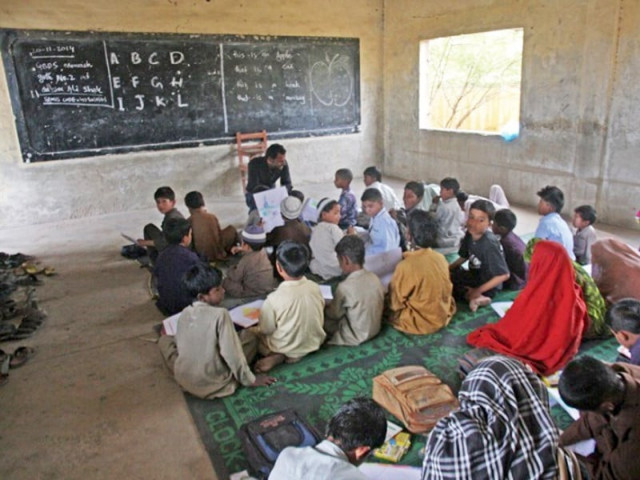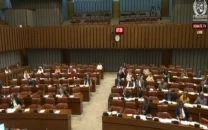Report lifts lid on education failure
Report shows that Khyber-Pakhtunkhwa (K-P) outperformed Punjab in education system's governance and management.

A new official report has revealed that Pakistan's education delivery system has become dysfunctional and all the 134 districts barring Islamabad were lagging behind on indicators ranging from learning outcomes to public financing.
The findings of the Planning Commission's District Education Performance Index Report 2023 underscored the human resource crisis in Pakistan where people are entering into job markets either with no or low education. For many, the crisis was worse than the economic crisis.
The report showed that Khyber-Pakhtunkhwa (K-P) outperformed Punjab in education system's governance and management. But Punjab was far ahead on the index of building education infrastructure. These two outcomes reflect the priorities of the Pakistan Tehreek-e-Insaf (PTI) and the Pakistan Muslim League-N (PML-N).
The report was launched by the United Kingdom High's Commissioner to Pakistan, Jane Marriott, and the Planning Minister Ahsan Iqbal on Friday. It showed that Pakistan's map was red on the performance indicators of education learning outcomes and public financing.
All the districts of the country fell in the categories of medium facing significant gaps in education delivery system to low the ones struggling to perform. The report said that the districts were suffering because of poor governance, highly poor learning outcomes and inadequate allocation of budgets.
None of Pakistan's 134 districts could get the rating of high performing in the education sector. Out of 134 districts, 133 fell in the category of medium to low, according to the District Education Performance Index Report.
The average 53.46 score means Pakistan's all districts were struggling with a dysfunctional education delivery system and required urgent attention to address gaps in basic requirements for education outcomes.
The districts having medium score are the ones that are facing significant gaps leading to compromised outputs and needing serious attention to improve service delivery. Also, 80% of the out-of-the-school children have never gone to the school and the parents had strong perception of poor quality education in the public sector.
"The learning domain index also paints a very sorry state of affairs as the whole map is red," Rafiullah Kakar, Member Social Sector of the Planning Commission, said. "The share of the education budget in the provincial development budgets is also highly inadequate. Up to 90% of the current budget for the education sector goes to paying salaries," he added.
Pakistan's national average score in the District Education Performance report is 53.46, placing the country in the low performance category.
The education sector was assessed on the basis of five indicators. Among these five domains, infrastructure & access scores the highest at 58.95, indicating some progress in expanding educational opportunities.
Inclusion (Equity & Technology) follows as the second-highest domain. Public Financing records the lowest score, highlighting the need for increased and better-targeted spending in the education sector, according to the report.
The learning domain also scores poorly, reflecting persistent low learning outcomes among students. Governance & Management, though slightly better than learning, still falls in the low category, mainly due to teachers' shortages and high bureaucratic turnover, showed the report.
The country's weakest areas were internet connectivity, numeracy and reading skills, tenure of the education secretary, share of education budget in the development budget and availability of schools and the allied facilities.
The better performance on the index of the passing rate of the matriculation was not depicting the true ground realities, as the lowest performing Kachhi district was having better scores than the top performing district of Balochistan on the index of matric passing ratio.
The districts have become redundant units and there is a need to map the education sector performance on the basis of political constituencies to hold the legislators accountable, said Kakar.
None of the 134 districts fall within the very high performance category, and only Islamabad falls into the high category, making it an outlier as the highest-performing district in the country, according to the report.
As many as 56 districts fell into the medium category, with Punjab leading with 32 districts, followed by K-P with 16, and Sindh with 8.
Alarmingly, more than half of Pakistan's districts 77 – fall into the low performance category. These low performing districts are predominantly in Balochistan and Sindh – 33 and 22 respecively – highlighting substantial inter-provincial disparities. Notably, all districts of Balochistan fall in the low education performance category, indicating severe challenges across the province.
Provincial outcomes
The overall best performing province may not be best in all the indicators, as Punjab having better overall rating performed poorly on the indicators of education sector governance and public financing, said Rafiullah Kakar.
K-P was the best in education sector governance, while Sindh was the best in the public financing domain, Kakar added. In Punjab, an education secretary stayed on the position for an average of six to eight months, resulting in poor governance in the country's largest province, he added.
Punjab outperformed other provinces in infrastructure and access with 73.36 score and on the index of inclusion it scored 75. But the provincial government scored lower in public financing and governance & management.
K-P excelled in governance & management and public financing but ranked lower in learning compared to other provinces. Sindh showed relative strength in public financing, where it ranked highest, but lagged in infrastructure & access and governance & management.
Balochistan faces severe challenges across all domains, ranking lowest in nearly all areas except learning, where it performed only slightly better than the worst-performing province.
Apart from Islamabad, the top 10 districts are exclusively from Punjab and K-P – 7 and 2, respectively. No districts from Sindh or Balochistan are represented among the top 10. The strong performance in these districts is largely due to high scores in Infrastructure & Access and Inclusion on the parameters of equity & technology.
In contrast, Balochistan dominated the lowest-scoring districts, with 6 out of 10. Infrastructure & Access, strength for top districts, is the most significant weakness for the lowest-ranked ones, with an average score of 36.39.
The report underscores the need for improving education outcomes across Pakistan with targeted investments, robust governance, and equitable resource distribution to address the substantial disparities in education performance across districts and provinces.
There is inadequate public financing for education, compounded by the low efficiency and effectiveness of the limited expenditures made. Pakistan's public education spending stood at 1.7% of Gross Domestic Product, significantly below the global average of 3.7%.


1735037907-0/Tribune-N-(2)1735037907-0-208x130.webp)
















COMMENTS
Comments are moderated and generally will be posted if they are on-topic and not abusive.
For more information, please see our Comments FAQ